To my way of thinking, and imagining, the canoe is intimately connected to my deep love of fresh water—streams, rivers and lakes—and fly fishing. When fishing large rivers or lakes, a canoe is a fly anglers best companion—with apologies to kayaks, float tubes and inflatable pontoons.
The canoe has paddled its way into the Canadian heart, imagination and psyche. I cannot imagine the Great White North sans canoe. Its deep roots penetrate the cultural, recreational, spiritual and mythic bedrock of the country and, consequently, remain a central element of history and geography, heritage and legacy, character and identity. It is not an exaggeration to refer to this vast country as Land of the Canoe.
The canoe is more than an effective means of transportation—a harmonious blend of form and function, design and craft, beauty and utility—ideally adapted to the landscape. It played a critical role in nation building by shaping the country through exploration and settlement, trade and commerce, war and recreation, sport and art.
It links First Nations people with European pioneers. Once a means of survival, it is now a tool of pleasure and relaxation, adventure and solitude. In extreme whitewater forms, it is an adrenaline rush of high emotion that sends heartbeats and metabolisms racing—infectious and obsessive, if not addictive.
Those who glance at a map of southwestern Ontario might conclude, erroneously, that Waterloo Region neither hears nor heeds the call of either the canoe or the fly rod. Situated equidistantly between Lake Huron and Lake Erie, the region appears landlocked and water starved.
A closer look reveals a different topography. As the Psalmist writes, its cup runneth over. The historic, heritage Grand River—my home water—has a watershed boasting myriad navigable tributaries and reservoirs. The Conestogo River joins the Grand at the village of Conestogo just north of Waterloo. The Eramosa River joins the Speed River in Guelph. The Speed River joins the Grand in Cambridge. The Nith River and Whiteman’s Creek join the Grand in Paris.
The Grand River Conservation Authority owns and manages no fewer than seven dams and reservoirs including: Shand Dam (built 1942), Luther Dam (1952), Conestoga Dam (1958), Laurel Dam (1968), Shade’s Mill Dam (1973), Woolwich Dam (1974) and Guelph Dam (1976)
Then there are the many rivers no more than a couple hours’ drive from my home in Waterloo: Maitland, Saugeen (main as well as Beatty and Rocky), Bighead, Nottawasaga, Beaver, Sydenham, Credit, Humber, Avon, Ausable and Thames, not to mention their numerous tributaries. Southwestern Ontario might not be Algonquin Park, Kawartha Lakes, Muskoka, Haliburton, Algoma or North of Superior, but it is far from an arid wasteland—for both canoeist and fly angler.
Waterloo Region and surrounding area have outfitting rentals and retailers, tackle stores, fly shops, guides, instructors, manufacturers of custom canoes and personal flotation devices (which used to be called lifejackets) and clubs, not to mention writers and artists associated with all things canoe and and fly fishing. For a number of years the region has played host to the KW Canoe Symposium, an annual celebration of the canoe. Princess Cinemas, the region’s premiere independent cinema, has presented for a number of years both the annual Paddling Film Festival and International Fly Fishing Film Festival.
Canoeing and fly fishing are two of the most intimate ways of learning about the character and personality, texture and tone, mood and atmosphere of a lake or a river. When it is not possible to be on the water, an armchair can be a place of understanding and appreciation so long as the angler or canoeist sitting in the chair has a book in hand–and perhaps a dram of malt whisky within reach. I have come to know the Grand River through paddle and fly rod. I have also learned about my home water through books spanning a wide range of subjects, expressed through prose, poetry and image. Following are four books that have meant the most to me, in addition to books about other places that speak to me with singular eloquence.
The Grand River
Because of my deep affection for the Grand River I am especially fond of The Grand River, a book of text and image produced by the brother-and-sister creative partnership of artist Gerard Brender à Brandis and writer Marianne Brandis, both of whom live in Stratford, Ontario.
Designated a Canadian Heritage River in 1984, the Grand courses through three hundred kilometres of southwestern Ontario from Luther Marsh in the highlands of Dufferin County, to Port Maitland on the north shore of Lake Erie. The river connects some of the province’s most alluring ecosystems, from the Elora Gorge to one of the country’s few Carolinian forests.
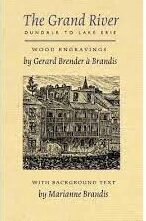
The river has also played a vital role in the area’s history, extending back 11,000 years to when indigenous people settled along its banks, through colonization by European missionaries, religious outcasts, refugees, military, disinherited farmers in search of land, labourers in search of jobs and settlers in search of homes. Formed when the last glaciers retreated 12,000 years ago, the Grand continues as a significant player in a post-industrial, multinational and transglobal landscape that supports a million residents in 40 municipalities.
Subtitled Dundalk to Lake Erie, The Grand River celebrates the waterway’s many moods, textures and colours. The creative travelogue is anchored by fifty-eight highly stylized wood engravings, accompanied by a series of short, meditative essays.
Marianne Brandis ruminates on the notion of riverness before exploring the river’s geography, history and ecology. She recalls some of the influential people who set down roots in the watershed, and examines various preservation and remediation strategies. Her narrative is a fusion of convergences, connections and conversations between history and geography, country and city, agriculture and industry, recreation and labour.
Gerard Brender à Brandis’s images combine numerous portraits of the river with images of flora and historical architecture, from the covered bridge at West Montrose and William Lyon Mackenzie King’s childhood home at Woodside in Kitchener, to the Alexander Graham Bell Homestead in Brantford.
The river portraits are self-explanatory, reflected through their titles: A Shining Ribbon of Water, Bankside, Fields Sloping to the River, The River Silenced by Winter, Spring Thaw Luther Marsh, Lake Belwood, Eroded Rocks Near Fergus, Elora Gorge, Near Inverhaugh, Remnants of a Bridge and Grand River at Doon, among others. I have canoed and fly fished at many of these locales.
Although the images are representational, serving as historical documentation, the engraver’s concerns are not restricted to verisimilitude. He carves his images in his cottage studio from en plein air sketches. The process of transformation from drawing to engraving entails innumerable aesthetic decisions. No line is left to chance. The prints are meticulously detailed, even delicate, revealing what I can best describe as an old-world pastoral sensibility. While static, many convey a sense of movement, whether flowing water, rustling leaves or clouds in breezy skies.
While turning the pages of The Grand River readers accompany brother and sister, artist and writer, on a leisurely journey through the seasons from the Grand’s headwaters to its mouth. Past and present meet at the river, representing the flow of time, the life cycle of those who lived along its banks and the timelessness of art and story.
THE GRAND RIVER WATERSHED
Subtitled A Folk Ecology, The Grand River Watershed is a collection of ecologically based poetry written by Karen Houle, a philosophy professor at the University of Guelph. She has published two previous poetry collections, Ballast (1995) and During (2000).
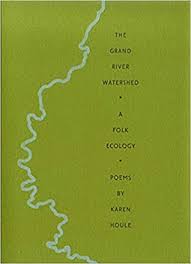
Following in a tradition that includes such eco-poets as American Gary Snyder and fellow Canadian Don McKay, Karen Houle transcends the languages of science (geology, entomology, anthropology, archeology, biology, ecology, botany) and humanities (geography, history, philosophy, journalism) to offer a rich postmodern poetry that celebrates the relationship between natural history and metamorphosis, ecology and transformation.
Those who think they already know the Grand by walking its riverside trails, canoeing its aquatic paths or casting fur and feather at its species of gamefish will be delightfully surprised to see with new vision through Karen Houle’s mysterious poetic lens.
Her poems are not always easy and accessible; they remind us of the adventure of exploration. Her Grand River is a complex web of relationships, of which humanity is but one of many pieces in a dynamic puzzle of animate and inanimate pieces.
. . . . . . . . . . . . . . .
All aquatic ecosystems have their secrets. I believe rivers are the most reticent and taciturn of all, which contribute to their engaging intrigue. Unlocking their secrets takes time, determination and effort, whether walking, wading or paddling or any combination of the three. Fly fishing is simply the most direct, most immediate key.
Learning about the Grand River—which I consider my home water even while preferring other headwater trout rivers–has been a work in progress, sometimes frustrating, at other times rewarding, not always satisfying but always pleasurable.
I have a confession to make. While the vast majority of fly fishing books are in one way or another instructional, intended to show how to practice the recreational sport, I have sought, and found, enrichment and enlargement primarily in other types of books. My personal library brims with some of the best technique/method manuals written by some of the most esteemed fly anglers in the last half century, a veritable Who’s Who: Joe Brooks, Ray Bergman, Lefty Kreh, Vincent Marinaro, A. J. McClane and Charles Waterman, among others. Still, in the still quiet hours of contemplation and reflection, I turn to the storytellers, whether they express themselves through creative non-fiction, memoir, short story, novel or poetry. Their names are too many to name here.
Nonetheless, I have been fortunate to find a couple of guides who have written books that have helped me solve some of the Grand’s most guarded secrets. They have not always given me the answers I sought, but they have always pointed me toward the right questions. I am also delighted to call them friends. I cannot imagine any fly angler who wants to enjoy a level of the enjoyment that accompanies success without seeking advice from this pair of Grand River Companions.
Fishing Ontario’s Grand River Country
The second edition of Fishing Ontario’s Grand River Country provides a thumb-nail history of the Heritage river and outlines the Grand River Fisheries Management Plan. Revised, updated and edited by Stephen May, the new volume supersedes the original, published in 1990. The earlier book, written by Liz Leedham with Jim Reid, sold out a number of years ago.
Few authors are better suited to write about the multi-species fishery. A member of KW Flyfishers, Steve May served as both a Stewardship Coordinator in Waterloo Region and as an urban fisheries technician for the Ontario natural resources ministry. He is a former professional guide and instructor with Grand River Troutfitters and remains a contract fly tier for Orvis.

Early in his professional angling career he produced Bob Izumi’s Real Fishing, Canada’s longest running angling television show. He has published articles in Canadian and International fly fishing publications including Canadian Fly Fisher, Fly Fisherman and Fly Fusion.
The book breaks down sections of the river, from its headwaters in Luther Marsh through its mouth on the north shore of Lake Erie, in addition to its tributaries. It serves as an invaluable guide to fishing all gamefish species including hatchery raised brown trout, and native smallmouth and largemouth bass, northern pike, walleye, perch, crappie, channel catfish and carp.
The book includes a new hatch chart and more detailed text in recognition of the increase of hatchery raised brown trout in the tailwater and the introduction of browns in the Conestogo River. ‘We weren’t stocking browns in the Conestogo River twenty years ago, walleye have improved in the reservoirs (Belwood and Conestoga lakes) and smallmouth bass have improved in the middle and lower sections of the Grand,’ Steve May confirms.
With a forward by Bob Izumi, the book brims with coloured photographs and includes seven maps detailing public access points and conservation areas.
Fly Fishing the Grand River
The husband-and-wife team of Ian Martin and Jane E. Rutherford share a love of fly fishing with a professional interest in aquatic insects. Fly anglers who fish the Grand River—myself included—are deeply grateful for their co-authorship of Fly Fishing the Grand River. Subtitled The Angler’s Vest Pocket Guide—in the tradition of such books as Art Flick’s Streamside Guide to Naturals and Their Imitations and Thomas Ames Jr.’s Hatch Guide for New England Streams—I am happy to call it the ‘Grand River Bug Bible.’
A founding member of KW Flyfishers, Ian Martin is an environmental biology and statistical consultant, while Jane Rutherford is a retired biology professor who taught at Wilfred Laurier University. They live atop a high limestone cliff overlooking the Grand tailwater and enjoy additional piscatorial solace in a modest salmon camp in Quebec.
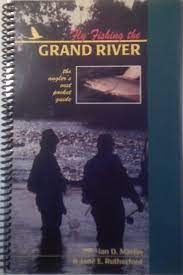
They spent five years researching insects and other invertebrates in the tailwater’s renowned brown trout fishery in preparation for Fly Fishing the Grand River.
The guide contains comprehensive information about the insects that inhabit the river, concentrating on hatching cycles. It features black, actual-size silhouette drawings (think of Roger Tory Peterson’s field guides to birds), colour photographs, hatch charts, fly tying strategies, bibliography and topographical map. It also offers practical on-river knowledge and advice gleaned from fly fishing the Grand, and many other rivers, for many years.
Fly Fishing the Grand River is a little book with encyclopedic gravitas. It is a must-have guide for anglers who fish southwestern Ontario waters who share insects and hatches with the Grand. The book benefits from the contributions of some of the Grand’s most accomplished fly anglers including Neil Houlding, Ted Shand and Dave Whalley, among others.
. . . . . . . . . . . . . . .
RIVER-PLACES
River-Places is one of Waterloo Region’s most handsome locally produced books about canoes and paddling craft, featuring poems by Bruce Lumsden and serigraphs by David Hunsberger, both of whom live in Waterloo Region. Both have been enthusiastic naturalists and canoeists for many years.
Bruce Lumsden’s poetry is direct and immediate. It is accessible lyric storytelling; a reader does not need an English degree to understand and appreciate it. He welcomes readers on an emblematic canoe trip which is a memory composite of many trips over many years. We join him as he heads north by car and leaves the ‘quite desperation’ of civilized society in the rearview mirror.
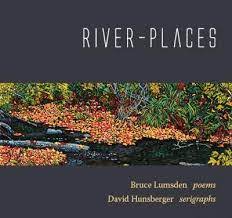
Readers accompany the poet and his companions after they hit the water, set up camp and enjoy a meal around the campfire, run rapids and wash out, portage and backpack, eventually returning home refreshed and restored. We share in the daily rituals and camaraderie that give deeper meaning to wilderness travel and exploration. We experience nature through the poet’s experience—from dawn to dusk to dawn, in all weathers. Occasionally he expresses thoughts and feelings that transcend the existential rituals of paddle and canoe.
David Hunsberger’s serigraphs are not inspired by specific poems. Rather the relationship between word and image is developed sympathetically and symbiotically. The highly stylized prints give readers a concentrated, intimate look at nature—its waters and shorelines, trees and plants, rocks and skies, not to mention the play of light and shadow that animates a world alive with wonder and mystery.
Reminiscent of the paintings of Tom Thomson, an obvious mentor to both poet and printmaker, David Hunsberger’s perspective on the landscape comes most often from the stern of a canoe while tracing the shoreline on a river or lake.
the river
A number of Canadian authors have written about rivers, from Hugh MacLennan (The Rivers of Canada) and Roderick Haig-Brown (Pool and Rapid: the Story of a River and A River Never Sleeps) to David Adams Richards (Lines on the Water) and Roy MacGregor (Original Highways). Subtitled Travelling the Great Rivers of Canada, MacGregor’s book includes a chapter on the Grand River titled ‘Return to Splendour’
Whether these works portray a single river or survey numerous rivers, the bodies of water are presented not only as settings, but as characters with personalities and temperaments. One of the most intimate portraits of a river with which I am familiar is Helen Humphreys’s the river (no capitals in title).
Rivers flow through her imagination like arteries through her body. She first waded into the prose of rivers with The Frozen Thames, a collection of vignettes that pays tribute to England’s famous river drawn from events that occurred each time it froze over between 1142 and 1895.
With the river Helen Humphreys paddles—imaginatively speaking—closer to home. For more than a decade she has owned a modest waterfront property on the headwaters of the Napanee River, in eastern Ontario not far from her home in Kingston.
With the eye of a visual artist, the lyric gifts of a poet (she has published four collections), the curiosity of a Victorian naturalist (many of her seven novels feature historical settings in her birthplace of England) and the attention to detail of a biologist, she celebrates the body of water that is closest to her heart and imagination—some readers might go so far as to say her soul.
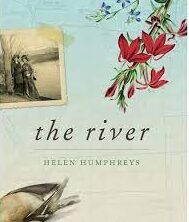
The book is equal parts natural history, biology, botany, geology, history, anthropology, geography, archeology, meteorology and historical fiction inspired by actual people and events. The literary miscellany incorporates fictional and non-fictional narrative, poetry, archival photographs and illustrations, paintings, drawings, maps, lists, found objects and featured photographs. It brings to mind the kind of minutiae and paraphernalia found in an artist’s notebook. Fly angling historians might draw comparisons to Muriel Foster’s Fishing Diary, compiled and illustrated between 1913-1949, and first published in Britain by Michael Joseph Ltd., in 1980.
This is nature filtered through the lens of culture, where ecology and philosophy intersect with art through poetic description and meditation. the river is a tactile, sensuous book that appeals to the senses, evoking the sights, sounds, smells and even tastes of the river and its immediate environs. Day and night, subsurface and surface, aquatic and terrestrial, flora and fauna meet at the convergence of water, earth and sky.
In her introduction Helen Humphreys asks: ‘How can we know anyone or anything?’ This beautiful book answers her rhetorical question with eloquence and elegance. For, as romantically anachronistic as it might sound, the river is a love letter to a watercourse that is as intimate and welcoming as home and family. It is a reminder that we must never grow weary of, or jaded by, such deep affection for our Good Green Earth and the intricate dynamism of all living things.